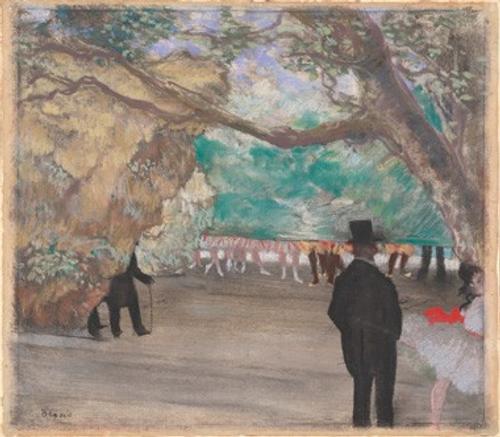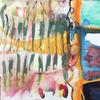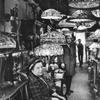National Gallery of Art Celebrates Degas's Love of the Paris Opéra in Exhibition on View March 1 through July 5, 2020
- WASHINGTON, DC
- /
- October 11, 2019

Washington, DC—Edgar Degas (1834–1917) is celebrated as the premier painter of dancers, a subject that dominated his art for nearly four decades. Degas's renowned images of the Paris Opéra are among the most sophisticated and visually compelling works he created. Celebrating the 350th anniversary of the Paris Opéra's founding, Degas at the Opéra will present approximately 100 of the artist's best-known and beloved paintings, pastels, drawings, prints, and sculpture. The exhibition will be on view from March 1 through July 5, 2020, accompanied by a fully illustrated exhibition catalog.
A music lover and regular visitor to performances, Degas explored both the public spaces of the Paris Opéra—auditorium, stage, and boxes—as well as more private ones, including dance studios and backstage. He was friends with many of the people he depicted in his paintings, from dancers, singers, and orchestra musicians to the formally dressed subscribers. The Opéra also fueled some of Degas's most daring technical innovations, including his first monotype, The Ballet Master (Le maître de ballet) (c. 1876, National Gallery of Art), and his wax sculpture Little Dancer Aged Fourteen (1878–1881, National Gallery of Art), which revolutionized the medium.
The Gallery has hosted several exhibitions on Degas over the years, including Wax Sculptures by Degas (1965–1973); Degas: The Dancers (1984–1985); Degas at the Races (1998); Degas/Cassatt (2014); and Degas's Little Dancer (2014–2015).
"Although there have been many exhibitions celebrating Degas's love of the ballet, this will be the first to celebrate his enduring fascination with the opera. The Gallery has the world's third largest collection of works by Degas, from which several of his key works depictions of the Paris Opéra will be on view in the show," said Kaywin Feldman, director, National Gallery of Art. "We are grateful to our partner organizations, the Musée d'Orsay and the Musée de l'Orangerie, other lending institutions and private collections, as well as BP America, Adrienne Arsht, and The Exhibition Circle at the Gallery for their support of this remarkable exhibition."
"BP respects the power of the arts to inspire better societies. As we help humanity advance by providing heat, light, and mobility, we’re also proud to support the arts for the creativity and passion they provide," said Mary Streett, senior vice president, U.S. Communications & External Affairs, BP America. "That’s why we’re honored to help bring the works of Edgar Degas to the National Gallery of Art. Degas is particularly special, as a European master who drew inspiration from America. We know museum visitors will do the same in this stunning exhibit."
Exhibition Organization
The exhibition is organized by the National Gallery of Art, Washington, and the Musée d'Orsay and Musée de l'Orangerie, Paris.
BP America is proud to be a sponsor of this Washington, D.C. exhibition as part of its support for the arts in the U.S.
Adrienne Arsht also kindly provided a leadership gift for this exhibition.
Additional funding is provided by The Exhibition Circle of the National Gallery of Art.
Exhibition Curators
The exhibition is curated by Degas expert Henri Loyrette, the general curator for the project, with Kimberly A. Jones, curator of 19th-century French paintings, National Gallery of Art; Leïla Jarbouai, graphic arts curator, Musée d'Orsay; and Marine Kisiel, curator, Musée d'Orsay.
Exhibition Tour
Musée d'Orsay, Paris, September 24, 2019–January 19, 2020
National Gallery of Art, Washington, March 1–July 5, 2020
About the Exhibition
Degas at the Opéra is the first exhibition to examine the importance of the Paris Opéra to the artist's work. The exhibition addresses the Opéra as an institution and Degas's passionate attachment to it through his personal relationships with successive Opéra directors, composers, corps de ballet, singers, musicians, conductors, and subscribers. From the mid-1860s through his later work made after 1900, the Opéra was the focal point for the artist. He explored its different spaces (orchestra, stage, boxes, foyer, corridors, dance studios), and examined the people active in those spaces. Degas's depiction of the dancer's body from every angle, under strain or in moments of relaxed waiting, reveals the psychological truth of the moment and is remarkable for its modernity in representing the human figure.
Degas used multiple viewpoints to frame a scene in unexpected ways. Through the contrasts of lighting, the juxtaposition of the darkened orchestra pit and the brightly lit stage, the study of movement, and the spontaneous gestures that masked patient study and constant practice, the Opéra became a laboratory that allowed him to explore the constant interplay of form and substance.
Rejecting the idea of painting from nature, Degas presented an Opéra filtered by memory and enriched by his imagination. He invents the scenes of orchestras, views of the auditorium, the stage and behind the scenes, dance classes, and examinations in the studio. Each scene and subject called for its own medium: paint for the slow precision of the dance classes; pastel for the dazzling colored ballets; black-and-white monotypes for the amorous liaisons behind the scenes; and drawing for the dancers' fleeting poses or movements.
Arranged thematically in eight galleries, Degas at the Opéra opens with his most famous works inspired by the Opéra: Mlle Fiocre a propos of the Ballet "La Source," (c. 1867–1868, Brooklyn Museum) and The Ballet from "Robert le Diable" (1871, The Metropolitan Museum of Art). Although they depict specific operatic performances, these paintings speak directly to Degas's profound attachment to and engagement with the Opéra as well as his distinctive approach to its presentation.
Degas also depicted his circle of friends, the performers, musicians, and others who were associated with the Opéra, including the portraits of soprano Rose Caron and cellist Louis-Marie Pilet, in addition to drawings of writer and librettist Ludovic Halévy. Among the highlights of Degas's musical circle is his portrayal of bassoonist Désiré Dihau that appears in his extraordinary and unconventional painting, The Orchestra of the Opera (c. 1870, Musée d'Orsay), as well as in Musicians in the Orchestra (Portrait of Désiré Dihau) (c. 1870, Fine Arts Museums of San Francisco).
The exhibition continues with works that illustrate Degas's interest in representing performers in candid moments in rehearsal rooms, offering rare glimpses into the backstage life and the rigorous training of the dancers. Several of the works on view are set in the practice rooms of the Opéra house on the rue Le Peletier—destroyed by fire in 1873—including The Dance Class (1873, Musée d'Orsay) and The Dance Class (c. 1873, National Gallery of Art).
While Degas showed little interest in documenting actual performances, he was intrigued by the public spaces of the Opera. He produced works that incorporate unconventional viewpoints into and out of the backstage wings, looking down at the stage from the opera boxes, or up from in the orchestra pit. Among the works on view that show such dynamic representations are Yellow Dancers (In the Wings) (1847/1876, The Art Institute of Chicago), The Curtain (c. 1880, National Gallery of Art), and Dancer with a Bouquet Curtseying on Stage (1878, Musée d'Orsay).
The Paris Opéra not only supplied a variety of subject matter for Degas to explore, but it also fueled his passion for experimenting with materials and format. Degas created decorative fans beginning in the late 1860s, using the semicircular format to explore compositional space in increasingly complex ways. Eight of these fans are on view, including Dancers (1879, Tacoma Art Museum), Ballet (c. 1880, Musée d'Orsay), and La Farandole (c. 1870, private collection). He took these experiments even further in a series of panoramic frieze paintings begun in the late 1870s. Among the six frieze paintings featured in this exhibition are Dancers in the Rehearsal Room with a Double Bass (c. 1882–1885, The Metropolitan Museum of Art), Dancers in the Green Room (c. 1879, Detroit Institute of Arts), and Dancers in the Classroom (c. 1880, Sterling and Francine Clark Art Institute).
The body of the dancer captured both in motion and at rest was a source of fascination and inspiration for Degas. Several drawings on view will show that while many served as studies for other works, it was the process of creation itself that motivated him. Some highlights on view are Three Nude Dancers (c. 1903, Arkansas Arts Center Foundation Collection) and Three Dancers (1900–1905, private collection) that depict dancers in motion, while other works, such as Dancer, Half-Length, Arms Crossed Behind her Head (c. 1890, Statens Museum fur Kunst) and Study of a Dancer (1874, private collection), show dancers in a specific pose.
Degas provided rare insights into the life of performers behind the scenes, especially that of the ballet "rat," as young dance students were known, and investigates both the humor and the seriousness of the difficult and demanding life of the ballet dancer. A bound volume of etchings, La Famille Cardinal (1938/1939, National Gallery of Art), as well as a series of monotypes, both of which are based on La Famille Cardinal, a study of lower-class Parisian life during the early years of the French government's Third Republic (1870–1940), written by Halévy. Degas's most famous work on the theme of the dancer in training, the wax sculpture, Little Dancer Aged Fourteen (1878–1881, National Gallery of Art), will be installed, alongside a bound volume of pencil sketches depicting ballet dancers (c. 1877, The J. Paul Getty Museum).
Even as his eyesight failed later in life, Degas continued to draw inspiration from the Opéra. The exhibition concludes with his late works, many of them in pastel, in which Degas abandoned the precision of his early works. Later works such as Blue Dancers (c. 1890, Musée d'Orsay), Dancer with Bouquets (1895–1900, Chrysler Museum of Art), and Ballet Scene (c. 1907, National Gallery of Art) show the vibrant colors and bold silhouettes that he favored.
Edgar Degas (1834–1917)
The eldest son of a Parisian banker, Degas reinforced his formal academic art training at the École des Beaux-Arts by copying old master paintings both in Italy, where he spent three years (1856–1859), and at the Musée du Louvre. Degas developed a rigorous drawing style and a respect for line early on that he would maintain throughout his career. His first independent works were portraits and history paintings, but in the early 1860s he began to paint scenes from modern life, starting with the world of horse racing. By the end of the 1860s, he turned his attention to the theater and ballet.
In 1873 Degas joined other artists who were organizing independent exhibitions without juries. He became a founding member of the group that would be known as the impressionists, participating in six impressionist exhibitions between 1874 and 1886.
Despite his long and fruitful association with the impressionists, Degas considered himself a realist. His focus on urban subjects, artificial light, and careful drawing distinguished him from other impressionists, who worked outdoors and painted directly from their subjects. An observer of everyday scenes, Degas tirelessly analyzed positions, gestures, and movement.
Degas developed distinctive compositional techniques, viewing scenes from unexpected angles and framing them unconventionally. He experimented with a variety of media, including pastels, photography, and monotypes, and used novel combinations of materials in works on paper and canvas as well as sculptures.
Degas was often criticized for depicting unattractive models from Paris's working class, but a few writers, like realist novelist Edmond de Goncourt, championed Degas as "the one who has been able to capture the soul of modern life." By the late 1880s Degas was recognized as a major figure in the Paris art world. Financially secure, he could be selective about exhibiting and selling his work. He also bought ancient and modern works for his own collection, including paintings by El Greco, Édouard Manet, and Paul Gauguin. Depressed by the limitations of his failing eyesight, he created nothing after 1912; when he died in 1917, he was hailed as a French national treasure. After his death, deteriorating sculptures whose existence had been unknown to all but his closest associates were found in his studio: 74 of them were cast in bronze over the next decades, and of the 70 that survived the process, 52 came to the National Gallery of Art as gifts of Mr. and Mrs. Paul Mellon, including Little Dancer Aged Fourteen.
Exhibition Catalog
Co-published by the Musée d'Orsay and the Musée de l'Orangerie / Réunion des musées nationaux, this beautifully illustrated, 323-page book presents a comprehensive exploration of Degas's fascination with the Paris Opéra. In inclusive scholarly essays and breathtaking illustrations, Degas expert Henri Loyrette, general curator of the exhibition, with Kimberly A. Jones, curator of 19th-century French paintings, National Gallery of Art; Leïla Jarbouai, graphic arts curator, Musée d'Orsay; and Marine Kisiel, curator, Musée d'Orsay, consider the Opéra as a whole, examining not only Degas's passionate relationship with it and his musical tastes, but also the infinite resources it provided him.
The exhibition catalog and other merchandise are available for purchase in a special installation near the exhibition exit, the West Building Shops, and the East Building Shops; shop.nga.gov; (800) 697-9350 (phone); (202) 789-3047 (fax); or mailorder@nga.gov.
Related Activities
Lecture
March 1, 2:00 p.m.
East Building Auditorium
Introduction to the Exhibition—Degas at the Opera
Kimberly A. Jones, curator of 19th-century French paintings, National Gallery of Art
A signing of the exhibition catalog follows.
Concert
Sound Impact
Agora Dance Company
Singers from the Washington National Opera Young Artist Program
Backstage at the Opera
March 15, 3:30 p.m.
West Building, West Garden Court
Degas spent his life immersed in music, but always as an onlooker. His relationship to the opera, including the dancers, orchestra musicians, patrons, and even the physical spaces—stage, backstage, orchestra pit, and boxes where his friends would sit—greatly influenced him as an artist, and showed up in his work regularly. This evening-length production tells the story of what was happening on those evenings when Degas attended the opera, and how it impacted the artist and the community in Paris in the 1870s and 1880s.
Films
The Paris Opéra (original title L'Opéra)
Date and time to be announced
East Building Auditorium
As the film opens in the fall of 2015, Stéphane Lissner is putting the finishing touches on his first press conference as director of the Paris Opéra while backstage, artists and crew prepare for a new season, opening with Schönberg's Moses und Aaron. At the same time, a promising young Russian singer begins at the Opéra's Academy, and after that the film's perspective shifts to his viewpoint. More characters begin to appear, including star choreographer Benjamin Millepied, who has taken over the role as Director of Ballet at Palais Garnier (the main house for the Paris Opéra, erected 1861–1875). Covering a full and eventful artistic season, The Paris Opéra is a well-observed vérité portrait of a major cultural institution. (Jean-Stéphane Bron, 2017)
La Danse: Le Ballet de l'Opera de Paris
Date and time to be announced
East Building Auditorium
The Paris Opéra Ballet is one of the world's great ballet companies. The film follows the rehearsals and performances of seven ballets: Genus by Wayne McGregor, Le Songe de Medée by Angelin Preljocaj, La Maison de Bernarda by Mats Ek, Paquita by Pierre Lacotte, Casse Noisette by Rudolph Nureyev, Orphée et Eurydice by Pina Bausch, and Roméo et Juliette by Sasha Waltz. The film shows the work involved in administering the company and the coordinated and collaborative work of choreographers, ballet masters, dancers, musicians, and costume, set, and lighting designers. (Frederick Wiseman, 2009)
Contact:
Laurie Tylecl-tylec@nga.gov
http://www.nga.gov
About National Gallery of Art
The National Gallery of Art and its Sculpture Garden are at all times free to the public. They are located on the National Mall between 3rd and 9th Streets at Constitution Avenue NW, and are open Monday through Saturday from 10:00 a.m. to 5:00 p.m. and Sunday from 11:00 a.m. to 6:00 p.m. The Gallery is closed on December 25 and January 1. With the exception of the atrium and library, the galleries in the East Building will remain closed until late fall 2016 for Master Facilities Plan and renovations. For information call (202) 737-4215 or visit the Gallery's Web site at www.nga.gov. Follow the Gallery on Facebook at www.facebook.com/NationalGalleryofArt, Twitter at www.twitter.com/ngadc, and Instagram at http://instagram.com/ngadc.















